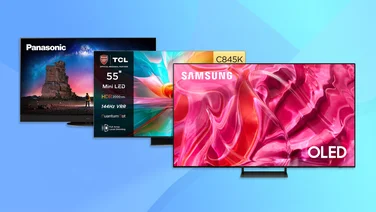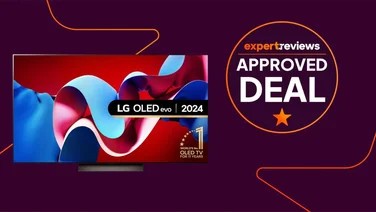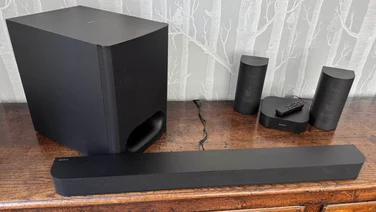To help us provide you with free impartial advice, we may earn a commission if you buy through links on our site. Learn more

Like just about every other TV manufacturer, LG has a penchant for labelling its televisions with long-winded model numbers comprised of what seem to be random numbers and letters.
The South Korean firm sells a huge range of televisions, but trying to tell them apart and work out the differences between them based on their model numbers is not a straightforward task.
Rather than proving enlightening, LG TV model numbers can be very confusing if you don’t know what to look for. That’s where we come in. This guide will help you make sense of LG’s tricky TV naming system and break down its entire lineup, from flagship OLEDs costing a small fortune to more affordable 4K LCD LED options.
With our help, you’ll know exactly what you’re getting if you decide that your next television is going to be an LG.
READ NEXT: Best TVs for gaming
What you need to know about LG’s 2024 TV lineup
LG’s new TV lineup was announced at CES in January and includes options to suit buyers with different needs across a wide range of price points. The company’s primary focus remains on OLED technology and it has expanded its OLED range to provide even more choice for those willing to splash the cash to secure exceptional picture quality.
Its LCD LED lineup is spearheaded by a couple of Mini LED options, one of which has native 8K resolution, with the rest of the range comprising models that either use LG’s NanoCell technology, a combination of NanoCell tech and quantum dot filters or have basic LED LCD panels.
A full breakdown of the pricing for all available models can be found further down the page.
LG TVs 2024: What’s new?
LG has added a new model to its OLED range: the Signature OLED T, a transparent television that only comes in a 77in screen size. The models that make up the remainder of the OLED range are all updates to pre-existing series, with the wireless M4 OLED replacing the M3, and the G4, C4 and B4 stepping into the shoes of their 2023 predecessors. LG has once again decided against releasing an A-series OLED in 2024.It’s all change on the processor front, however, with the OLED T, M4 and G4 powered by the new α11 AI Processor 4K, a chip so powerful LG decided to skip α10. The brand says the new chip can deliver 4x the AI performance, has 1.3x the processing power and 1.7x the graphical performance of last year’s α9 processors.
The α11 chip also unlocks some new processing tools and features. LG’s AI Picture Pro processing technology will now work regardless of content type or source, where previously it was limited to specific streaming services or broadcasts.
α11-powered models also gain access to Object Enhancing by Visual Perception and AI Director Processing. The former analyses each pixel in a particular scene, picks out specific objects in that scene that require additional emphasis and enhances them accordingly. AI Director Processing, meanwhile, detects a content creator’s intended colour tone and uses this information to enhance on-screen colour expression.
Additionally, the α11 processor boosts audio reproduction thanks to its new virtual 11.1.2-channel surround sound upmixing capabilities and support for Voice Remastering, which extracts the voice signal separately from other elements of content to ensure dialogue is delivered clearly.

The C4 gets an upgrade thanks to the latest iteration of the α9 AI Processor 4K and, like the models above it, has seen its refresh rate boosted from 120Hz to 144Hz, which is great news for PC gamers. The entry-level B4 OLED remains limited to 120Hz but houses a new α8 AI Processor 4K. All OLED models now come with Chromecast built-in and support Google Home, something that’s been conspicuously absent in previous years.
The selection of screen sizes available across the OLED lineup has grown, too. There’s a 65in M4 to join the 77in, 83in and 97in models, with the B4 now available in 48in in addition to 55in, 65in and 77in.
More pertinent to those with smaller budgets is the arrival of webOS 24. LG’s smart platform has received numerous upgrades, most of which apply to all LG TVs, not just its OLEDs.
Quick Cards, which were introduced in 2023 to enable quicker navigation and access to relevant content, are smaller and more dynamic. The number of individual user profiles has been increased to 10 and each profile can now be password-protected, while every user can tailor picture quality to their personal taste using LG’s Picture Wizard.
And, in great news for consumers, LG has committed to upgrading the operating system on all of its 2024 TVs for five years. This means that if you purchase a new LG TV this year, you’ll be good all the way up to webOS 28.
LG TVs 2024: Breaking down the model numbers
LG’s model numbers may look daunting at first glance, but they’re actually relatively easy to decipher once you know what each of the component parts refers to.
OLEDs are handled slightly differently from the rest of LG’s range so let’s look at those first. Taking the OLED77C44LA as our example, the model number can be broken down into five parts:
OLED: This indicates that the TV uses an Organic Light-Emitting Diode (OLED) panel.
77: The two digits following the OLED panel type illustrate the TV’s screen size. In this case, we’re looking at a 77in model.
C: The first letter of an OLED’s model number indicates the series to which the TV belongs. “Z” series OLEDs are the company’s most expensive, while the “A” series are entry-level options, though there’s no A series being released in the UK in 2024.
4LA: These additional numbers and letters are the least important. They indicate the sales region, the type of broadcast tuner and the type of stand the TV uses.

QNED and NanoCell model numbers take a different form but the general gist is the same. Let’s use the 65QNED86T6A as our example:
65: Here, we get the screen size before the panel type, so this is a 65in model.
QNED: Next comes the panel type, which in this case is a Quantum NanoCell Emitting Diode (QNED) panel.
65: This reflects the series the TV belongs to. The higher the number, the more advanced (and expensive) the TV is.
T6A: The last section of the model number relates to the same things as it does on an OLED model, namely sales region (or sometimes a specific retailer), tuner type and stand type.
LG TVs 2024: The models
OLED TVs
OLEDs make up a significant proportion of LG’s TV lineup and that remains the case in 2024. The lineup looks very similar to last year’s, bar the addition of the Signature OLED T.
LG Signature OLED T
Make no mistake about it, the Signature OLED T is not a television designed for mainstream consumers. In fact, as far as we’re aware, it’s not even available to buy at the moment.
It’s a wireless, transparent TV that transforms into a more traditional OLED set when an in-built “contrast curtain” is raised behind it and is only being made in a 77in screen size. There will be standalone, against-the-wall and wall-mount options available, however, and the TV can be customised with floating shelves on either side of the screen.

LG OLED evo M4
The M4 is a wireless television that uses a Zero Connect wireless transmission box to beam audio and video signals to the TV. This removes the need to run lots of cables to the back of the set and gives you greater freedom in where you position it. It supports 4K resolution at up to 144Hz and, like the G4 below, makes use of LG’s Brightness Booster Max technology to deliver searing peak brightness. The M4 is set to be released in 65in and 97in screen sizes in July, with 77in and 83in models arriving later in the year.

OLED65M4 | TBC
OLED77M4 | TBC
OLED83M4 | TBC
OLED97M4 | TBC
LG OLED evo G4
Like the M4, the G4 is powered by LG’s most powerful chip, the α11 AI Processor 4K, and is capable of delivering some of the best picture quality around. Four of the five screen sizes use an MLA (Micro Lens Array) OLED panel, with only the enormous 97in option missing out. This, combined with Brightness Booster Max, allows the G4 to hit previously unseen levels of brightness. Four HDMI 2.1 ports supporting all the latest gaming features make it a superb pick for gamers, too. Previously, the G4 was specifically designed for wall–mounting and didn’t come with a stand but LG has added stand options for the 55in and 65in models this year. The model numbers that come with a stand end in LS, while those that are made for wall-mounting end in LW. You can read more about just how great this TV is in our LG G4 OLED review.

OLED55G45LW (£1,939) | Check price at Amazon
OLED65G45LW (£2,499) | Check price at Amazon
OLED77G45LW (£3,599) | Check price at Amazon
OLED83G45LW (£5,299) | Check price at Amazon
OLED97G4 | TBC
LG OLED evo C4
The C series is LG’s most popular OLED and strikes a great balance between price and performance. It misses out on the α11 AI Processor 4K but instead runs the seventh-generation α9 – a new iteration of the chip found in last year’s G series. It also makes do with Brightness Booster technology rather than Brightness Booster Max but still hits impressive levels of brightness for an OLED.
Its gaming credentials are bolstered by an improved refresh rate of 144Hz and it remains available in a wide range of sizes, including 42in and 48in, models that have proved a big hit with those wanting premium picture quality in a more compact package. For more information about this TV, check out our LG C4 OLED review.

OLED42C44LA (£999) | Check price at Amazon
OLED48C44LA (£1,199) | Check price at Amazon
OLED55C44LA (£1,599) | Check price at Amazon
OLED65C44LA (£2,299) | Check price at Amazon
OLED77C44LA (£2,969) | Check price at Amazon
OLED83C44LA (£4,729) | Check price at Amazon
LG OLED B4
The B4 is the entry point into LG’s OLED range and makes a few concessions to hit a more accessible price. It forgoes LG’s evo panel and uses a less advanced processor – the new α8 AI Processor 4K, while its refresh rate is limited to 120Hz. It’s not as bright as a result and it misses out on a few image processing tools, but it has gained two full-bandwidth HDMI 2.1 ports, taking its total to four. If you want great gaming support, impressive performance and a comprehensive smart platform but don’t have the budget for a C or G series OLED, this is the most appealing option in LG’s roster. There’s even a new 48in model this year, so those with limited space can enjoy a more affordable OLED experience.

OLED48B46LA | TBC
OLED55B46LA (£899) | Check price at Amazon
OLED65B46LA (£1,299) | Check price at Amazon
OLED77B46LA (£1,923) | Check price at Amazon
Quantum Dot Mini LED TVs
This pair of TVs make use of a trio of technologies: quantum dot, NanoCell and Mini LED. The latter means the LEDs illuminating the panel are much smaller than those found on basic LED panels. As a result, they can fit more LEDs (and subsequently dimming zones) for more granular contrast control.
LG QNED99
With no Z4 OLED in the lineup this year, the LG QNED99 is the only 8K option in the company’s portfolio for 2024. It’s only available in two large sizes – 75in and 86in – is powered by the seventh-gen α9 AI Processor 8K and uses a Mini LED, quantum dot NanoCell panel.

75QNED99T9B | TBC
86QNED99T9B | TBC
LG QNED91

The QNED 91 sits at the top of LG’s 4K LCD range and uses a Mini LED panel that combines NanoCell and quantum dot technology. It’s available in 65in, 75in and 86in screen sizes and uses the same processor found in the LG B4, the α8 AI Processor 4K. You can read more about this particular model in our LG QNED91 review.
65QNED91T6A (£1,699) | Check price at John Lewis
75QNED91T6A (£2,500) | Check price at John Lewis
86QNED91T6A (£3,799) | Check price at John Lewis
Quantum Dot NanoCell LEDs
These options use LG’s NanoCell technology, which helps prevent colours bleeding into each other, in combination with a quantum dot filter that unlocks a wider colour gamut and improved colour saturation. Because they use normal-sized LEDs rather than smaller Mini LEDs, their contrast performance is typically inferior to the Mini LED options above.
LG QNED89

This is the largest TV in LG’s lineup this year, with its 4K QNED panel measuring an enormous 98in across its diagonal. Like the B4 OLED and QNED91, it’s powered by the α8 AI Processor 4K and has a refresh rate of 120Hz. Its 2.2-channel audio system can output 40W and supports virtual 9.1.2-channel upmixing courtesy of α8 AI Sound Pro.
98QNED89T6A (£5,500) | Check price at LG
LG QNED87

The QNED87 has the same processor and refresh rate as the QNED89 above but is available in three smaller screen sizes and uses an edge-lit panel rather than a direct-lit one. It also has a less advanced 2.0-channel audio system and a central stand, rather than two feet at either side of the panel.
55QNED87T6B (£950) | Check price at LG
65QNED87T6B (£1,200) | Check price at LG
75QNED87T6B (£1,700) | Check price at LG
LG QNED86

The QNED86 gets its own model number despite being very similar to QNED87. In fact, looking at the specs, we’ve been unable to discern any meaningful differences between the two. They also cost the same, so there doesn’t seem to be any benefit choosing one or the other aside from the greater range of screen sizes available on the QNED86.
50QNED86T6A (£900) | Check price at LG
55QNED86T6A (£950) | Check price at LG
65QNED86T6A (£1,200) | Check price at LG
75QNED86T6A (£1,700) | Check price at LG
86QNED86T6A (£2,500) | Check price at LG
LG QNED85

This is ostensibly the same TV as the QNED86 above but has a different style of stand. Where the QNED86 sits on a central pillar, the QNED85 uses two feet on either side of the panel.
86QNED85T6C (£2,499) | Check price at LG
77QNED85 | TBC
LG QNED80

The QNED80 is the cheapest option in LG’s QNED range. It’s powered by a less advanced chip than the rest of the lineup (the seventh-generation α5 AI Processor 4K) but available in a wide range of screen sizes. Other features it drops include support for DTS and Dolby Atmos audio and its panel refresh rate is limited to 60Hz, meaning it’s not as good for current-gen gamers.
43QNED80T6A (£500) | Check price at LG | John Lewis
50QNED80T6A (£550) | Check price at LG | John Lewis
55QNED80T6A (£600) | Check price at LG | John Lewis
65QNED80T6A (£950) | Check price at LG | John Lewis
75QNED80T6A (£1,499) | Check price at LG | John Lewis
86QNED80T6A (£2,500) | Check price at LG | John Lewis
NanoCell TVs
This pair of tellies use a LED panel with LG’s proprietary NanoCell technology. This uses a different pixel structure to what you’ll find on basic LED panels with the intention of widening viewing angles and delivering improved colour uniformity.
LG NANO82/NANO81

We’re listing these TVs together as they have identical specs; the only difference we’ve been able to find is that the NANO82 is available in one extra screen size (86in). Both run the same α5 AI Processor 4K found in the QNED80 and use direct-lit NanoCell panels with 60Hz refresh rates. As such, they’re not going to deliver the same level of colour performance as their QNED stablemates, nor can they handle 4K@120Hz when hooked up to a PlayStation 5 or Xbox Series X.
43NANO82T6B (£320) | Check price at Amazon
50NANO82T6B (£349) | Check price at Amazon
55NANO82T6B (£425) | Check price at Amazon
65NANO82T6B (£699) | Check price at LG
75NANO82T6B (£1,000) | Check price at Amazon
43NANO81T6A (£400) | Check price at LG | Currys
50NANO81T6A (£450) | Check price at LG | Currys
55NANO81T6A (£550) | Check price at LG | Currys
65NANO81T6A (£699) | Check price at LG | Currys
75NANO81T6A (£1,000) | Check price at LG | Currys
86NANO81T6A (£1,700) | Check price at LG | Currys
LCD LED
The other entries in the 2024 lineup use basic LCD LED panels and are the most affordable 4K options LG offers.
LG UT91

The UT91 sits at the top of the range and is powered by the same processor found in the lower-tier QNED and NanoCell models. It doesn’t use a quantum dot filter or NanoCell technology, however.
43UT91006LA (£449) | Check price at LG | Amazon
50UT91006LA (£500) | Check price at LG | Amazon
55UT91006LA (£600) | Check price at LG | Amazon
65UT91006LA (£749) | Check price at LG | Amazon
75UT91006LA (£999) | Check price at LG | Amazon
LG UT81

While powered by the same seventh-gen α5 AI Processor 4K chip as the UT91, the UT81 uses a direct-lit panel rather than an edge-lit one, and misses out on local dimming, so its contrast performance isn’t as impressive. It’s cheaper as a result, and also uses a different stand.
43UT81006LA (£330) | Check price at LG | Currys
50UT81006LA (£399) | Check price at LG | Currys
55UT81006LA (£450) | Check price at LG | Currys
65UT81006LA (£599) | Check price at LG | Currys
75UT81006LA (£850) | Check price at LG | Currys
86UT81006LA (£1,400) | Check price at LG | Currys
LG UT80

The only notable difference between this and the UT81 is the style of stand. Where the UT81 uses a central crescent-shaped stand, the UT80 stands on two feet. There’s no 86in screen size for this model number, either.
43UT80006LA (£329) | Check price at LG | John Lewis
50UT80006LA (£400) | Check price at LG | John Lewis
55UT80006LA (£449) | Check price at LG | John Lewis
65UT80006LA (£600) | Check price at LG | John Lewis
75UT80006LA (£850) | Check price at LG | John Lewis






